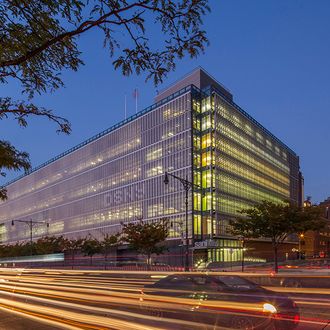
For years, le tout Tribeca fumed at the prospect of a hulking garbage-truck garage and salt shed just north of the neighborhood, at the corner of West Street and Spring Street. Now that both are done, it looks like the quality of life in one of the city’s super-premium zip codes won’t collapse, and neither will its property values. Still, the rest of us should thank James Gandolfini, Lou Reed, Michael Stipe, and the whole posse of outraged celebrities who fought it. Rather than killing the project, they made it more visible, forcing the city to house a dirty job in the dignity of actual architecture.
The pair of surprisingly stylish buildings, designed by Dattner Architects and WXY Architecture + Urban Design, takes its place in a zone of infrastructure behemoths and electrifyingly expensive homes. Philip Johnson’s Urban Glass House sits alongside the Holland Tunnel’s emissions-rich approaches and its muscular brick ventilation tower. UPS delivery vehicles rumble in and out of a handsome art deco garage. The immense and mostly empty St. John’s Terminal Building stretches for three blocks along Washington Street, making developers salivate at the thought of tearing it down.
Every morning, hours before dawn, dozens of Sanitation Department trucks rumble and groan onto West Street, fanning out into districts one, two, and five (lower Manhattan and midtown). Their new home might have been a utilitarian concrete box; instead, it’s a bulky but elegant fortress, skinned in glass and armored in perforated metal fins. Drivers will see mostly its formidable western flank, where the metal scales acquire a different texture depending on whether you’re approaching from uptown or downtown. Even the signage puts on a show: a white-on-silver DSNY logo appears and vanishes as you move, and the lower-case word sanitation wraps the corner like a news ticker or an understated Barbara Kruger. A thin veneer of offices lines the south side of the building, the walls lit and color-coded by district, so that at night the building appears candy-striped. How ironic that the rare splash of brilliance in a color-challenged city should adorn a garbage garage.
The heart of the building — and the biggest-ticket item in the $200 million budget — is a curling highway-style ramp, high and tough and wide enough for a big truck drag race, should the need arise. And I can see it arising, in an action movie, say. The evening I visited, the maintenance bays’ windows gave onto Jersey City’s towers silhouetted against a crimson sunset, giving the place a startlingly cinematic glamour. Even from neighboring apartments, the facility looks like a set: the long planted roof follows the angle of the ramp, making it the perfect place to land if you happen to be leaping from a helicopter wearing skis.
Across Spring Street sits Dattner’s equally photogenic concrete shed, filled with mountains of road salt so high that front-loaders blaze paths up the slope. Its rough crystalline facets verge on the flamboyant — they should inspire a line of salt-crystal-shaped saltshakers. Yet the architectural message is a serious one. The city has no back of the house, where all the noisy, smelly operations can be tucked out of sight. The poor have to tolerate more than their share of ramps, pipes, viaducts, tunnels, treatment plants, substations, depots, but in the end everyone has to coexist with these bulky encumbrances of urban life. The architects have done a good job of prettifying ugly processes to salve the sensitivities of the rich, but they have done more than that. Their buildings demonstrate what the celebrities couldn’t see: that we all live under the hood of a great machine, and we have to care for it with pride.






























